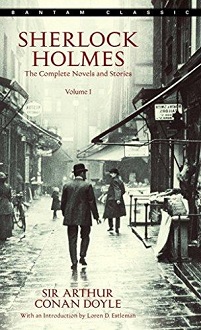
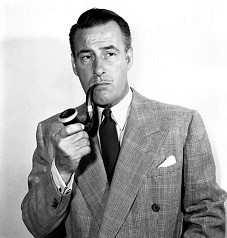 The New Adventures of Sherlock Holmes (1939-47) aired “The Adventure of the Dying Schoolboys” on November 9, 1946. During this incarnation of Sherlock Holmes on radio (the first coming in the early 1930s and the last running to 1959), Basil Rathbone and Nigel Bruce reprised their Universal studio film roles of Sherlock Holmes and Dr. Watson for close to 220 episodes. Afraid of being typecast–and following the cancellation of further Holmes films–Rathbone wanted out of his radio role. Though the show’s sponsor at the time, Petri Wines, offered him a generous bump in compensation if he would continue, Rathbone declined. Following his final episode as Holmes at the end of May 1946, the Holmes character was played by popular British actor Tom Conway (who was superb, and plays Holmes in this episode), with Bruce staying on until the series end in 1947. For several years during this series (including this episode), scripts were written by the team of future F&SF co-founder Anthony Boucher, and Denis Green. Boucher, a diehard Holmes fan, would pen the outlines of scripts and Green would supply the details. They worked well together and the show flourished.
The New Adventures of Sherlock Holmes (1939-47) aired “The Adventure of the Dying Schoolboys” on November 9, 1946. During this incarnation of Sherlock Holmes on radio (the first coming in the early 1930s and the last running to 1959), Basil Rathbone and Nigel Bruce reprised their Universal studio film roles of Sherlock Holmes and Dr. Watson for close to 220 episodes. Afraid of being typecast–and following the cancellation of further Holmes films–Rathbone wanted out of his radio role. Though the show’s sponsor at the time, Petri Wines, offered him a generous bump in compensation if he would continue, Rathbone declined. Following his final episode as Holmes at the end of May 1946, the Holmes character was played by popular British actor Tom Conway (who was superb, and plays Holmes in this episode), with Bruce staying on until the series end in 1947. For several years during this series (including this episode), scripts were written by the team of future F&SF co-founder Anthony Boucher, and Denis Green. Boucher, a diehard Holmes fan, would pen the outlines of scripts and Green would supply the details. They worked well together and the show flourished.
 Since 130 years have passed since the first story of Sherlock Holmes and Dr. John Watson appeared in Beeton’s Christmas Annual magazine for December 1887 (A Study in Scarlet), much has been written, filmed, or dramatized of the most famous sleuth on the planet. In fact, the Wikipedia page devoted to Holmes, states that the Guinness Book of World Records’ lists the Holmes character as “the ‘most portrayed movie character in history’ with more than 70 actors playing the part in over 200 films.” And while hardly all inclusive, Wikipedia notes that those writing Holmes pastiches number the likes of Anthony Burgess, Neil Gaiman, Dorothy B. Hughes, Stephen King, Tanith Lee, A. A. Milne, and P. G. Wodehouse–to which I will add Manly Wade Wellman, Philip Jose Farmer, James Lovegrove, George Mann, Kim Newman, and Fred Saberhagen. It’s a sure bet there have been many others of genre interest over the years who have tried their hand at a Sherlock Holmes novel as well.
Since 130 years have passed since the first story of Sherlock Holmes and Dr. John Watson appeared in Beeton’s Christmas Annual magazine for December 1887 (A Study in Scarlet), much has been written, filmed, or dramatized of the most famous sleuth on the planet. In fact, the Wikipedia page devoted to Holmes, states that the Guinness Book of World Records’ lists the Holmes character as “the ‘most portrayed movie character in history’ with more than 70 actors playing the part in over 200 films.” And while hardly all inclusive, Wikipedia notes that those writing Holmes pastiches number the likes of Anthony Burgess, Neil Gaiman, Dorothy B. Hughes, Stephen King, Tanith Lee, A. A. Milne, and P. G. Wodehouse–to which I will add Manly Wade Wellman, Philip Jose Farmer, James Lovegrove, George Mann, Kim Newman, and Fred Saberhagen. It’s a sure bet there have been many others of genre interest over the years who have tried their hand at a Sherlock Holmes novel as well.
For the story of how Sherlock Holmes first came to radio, and who was responsible for it, read the introduction to “The Adventure of the Devil’s Foot” here, and discover why all Holmes fans are indebted to a most remarkable woman.
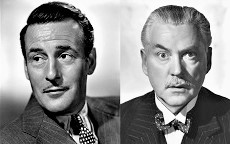
{Tom Conway (1904-67) & Nigel Bruce (1895-1953)}
Our last Sherlock Holmes episode was in November of 2018, and before that in February of 2017, so I felt it was high time we visited Watson and Holmes again.The title of this episode pretty much says it all. Holmes and Watson are called to an elite school for boys to unravel the mystery of why so many of them have died in a fairly short period of time. I’m not sure I buy the resolution, but it is an otherwise well-written script with some nice touches and definitely worth a listen. Tom Conway starred in dozens of films from the 1940s to the mid-60s. Of interest to genre fans were his roles in a couple of Val lewton pictures, notably the classic Cat People (1942) with sultry co-star Simone Simon, and 1943’s I Walked with a Zombie (written by SF suthor Curt Siodmak), while brother George Sanders (1906-1972) would play The Saint in films, and also in several popular Falcon films until, in 1942, he tired of the role and handed it off to brother Tom in the film The Falcon’s Brother.While Tom and George were brothers and were born with the same last name, they felt since both worked in movies that to forestall any confusion they would flip to see who retained the Sanders family name. George won.
Play Time: 29:53
{Not yet 10 days after Halloween when this episode aired, the neighborhood gang still had enough candy left over for several more sugar highs, so they found themselves walking to the nearby newsstand more often than usual. Still thinking over the Sherlock Holmes detective mystery they’d just listened to the night before, they were in the mood for more. Ten Detective Aces (1928-49) filled the bill for mystery and murder quite nicely. It was a monthly until 1943, but no doubt due to the war paper shortage became bi-monthly with its December 1943 issue. Thrilling Detective (1931-53) was also replete with tales of corruption, mayhem, and murder and was a perfect complement to other detective pulps of the time. Thrilling Wonder Stories (1936-55) while definitely not a crime/detective magazine, nevertheless gave its readers an adrenalin rush of a different sort, with damsels in distress not from gangsters but aliens, and not saved at the last minute by a detective but by a square-jawed spaceman–both manifestations of the eternal hero, though at different times and in different places forever fighting the never-ending forces of evil. TWS was a quarterly in 1945, here in 1946 it managed 5 issues (the issue below was its 4th of the year and its last quarterly), and in 1947 it would rev up to a bi-monthly schedule.}
[Left: Ten Detective Aces, Oct. 1946 – Center: Thrilling Detective, Oct. 1946 – Right: Thrilling Wonder Stories, Fall 1946]
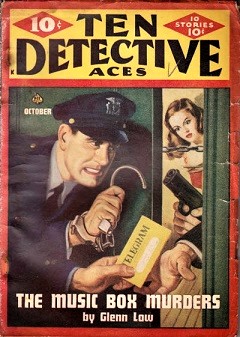
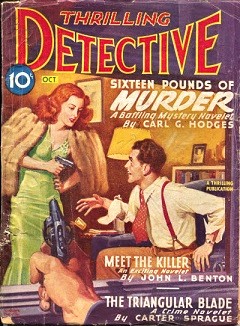

To view the entire list of weekly Old Time Radio episodes at Tangent Online, click here.